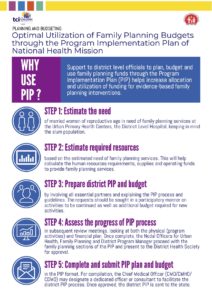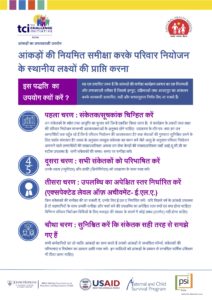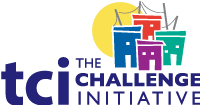India Toolkit: Advocacy
- Home
- Help and Support
- Close
- Toolkits
- Global Toolkit
- AYSRH Toolkit
- Hub Toolkits
- Core High-Impact Practices
- Gender Essentials Mini Course
- Close
- Resource Collection
- Community of Practice
- Coaching
- Log In/Register
- My Profile
- English
Planning and Budgeting
Optimal Utilization of Budgets for Family Planning through the Program Implementation Plan of National Health Mission
 Purpose: To provide guidance to district officials and NGO partners on the specific steps of planning and budgeting for Family Planning (FP) through the annual Program Implementation Plan (PIP) of the National Health Mission (NHM).
Purpose: To provide guidance to district officials and NGO partners on the specific steps of planning and budgeting for Family Planning (FP) through the annual Program Implementation Plan (PIP) of the National Health Mission (NHM).
Audience
- Chief Medical and Health Officers (CMHO/CDMO/CMO)
- Chief Medical Superintendents (CMS)
- Nodal Officers -Urban Health and FP
- Persons In-Charge of Facilities
- Medical Officers in Charge (MOIC)
- District Program Managers (DPM)
- NGO representatives
Background: Reduction of unmet need for FP can improve infant and maternal health and reduce the high levels of mortality. Understanding this linkage places FP within a broader context of health and creates the impetus to maximize the level of funding that is available for FP activities through the PIP. NHM’s Annual PIP is the mechanism through which districts can plan, budget and request for funds for FP.
Apart from the funds for District Women’s Hospitals, Medical Colleges and District Hospitals, the funds are especially required for a good functioning of the Urban Primary Health Centers (UPHCs) and the Urban Community Health Centers (UCHCs). These facilities require, but often lack adequate human resources, equipment, and supplies to support the provision of services to the urban population of the district. They also lack other required resources to implement innovative FP measures such as workplace interventions, strategies for male engagement in FP, induction training of private providers on sterilization and Post-Partum Intra Uterine Contraceptive Device (PPIUCD) insertion services. The mechanism of the NHM’s PIP can be used to allocate funds to meet the FP needs of the urban population.
Inadequate planning and under-utilization of available funds have been major reasons for the insufficiency of FP services in the public sector. This has resulted in low demand and barriers to access services especially for marginalized populations including the urban poor.
Evidence of the Impact
Support to district level officials through the Urban Health Initiative (UHI) in planning, budgeting and requesting for funds to support FP through the PIP produced substantially increased amount of funding being allocated and utilized for FP interventions.
Better planning at the city level and inclusion of listed and unlisted slums in UHI intervention cities helped increase the total amount of funds allocated for FP in the state and district PIPs, which allowed the following positive changes to be made:
- Increased allocation of Urban Accredited Social Health Activities (ASHAs) in UHI intervention cities
- Increased budget for male and female sterilization procedures and associated client incentives (wage loss compensation), resulting in an increased number of clients
- Better utilization of the FP budget. For example, the Contraceptive Technology Updates (CTU) workshops were conducted in UHI cities with funding through the PIP
- The PIP was also used to increase the number of contracted-in-doctors and counselors to provide services in the public sector hospitals
- Procurement of additional supplies and commodities
SIFPSA and NHM-UP, with technical assistance from the EAQ project led by Population Services International (PSI): Facilitated the establishment of a Public Private Partnership model for strategic purchase of FP services. The districts were able to mobilize 180 million rupees from the PIP to reimburse the private sector for FP services over a period of one and a half years (2016-2017).
Guidance on Planning, Budgeting and Requesting FP Funding in the PIP
The details of the seven UHI trainings that were effective in strengthening the capacity of providers and staff are mentioned below:
Estimate the Need
Estimate the population of Married Women of Reproductive Age (MWRA) in need of FP services at the UPHC/District Women Hospital (DWH)/District Combined Hospital (DCH) level in urban areas, keeping in mind the slum population of the city (Refer to the TCIHC’s urban mapping and listing tool).
Estimate Required Resources
Prepare District PIP and Budget
Before any PIP is formulated, the CMHO/CDMO/CMO/CS should invite the Additional Chief Medical Officers (ACMOs), Nodal Officers – Urban Health and FP, Deputy CMHO/CDMO/CMO, CMSs, DPMs, Assistant Research Officers (AROs), Medical Officers In-Charge (MOICs) of UPHCs in the district, development partners (national and international NGOs) and representatives of the accredited private sector facilities. They should be explained the PIP process as per the PIP guidelines received from the State and the Central government. Their requests should be sought in a participatory manner, on areas /issues/activities to be continued in the coming PIP as well as additional budget required for new activities, such as renovation of facilities, additional facilities in urban areas, additional staff, equipment and supplies, IEC materials and their distribution, cost for Fixed Day Static (FDS) services, community activities related to FP and health and proposed innovations (Refer NUHM PIP Guideline final 2016-17).
Assess the Progress
Complete and Submit the PIP Plan and Budget
Disseminate Information on Approved Funds
Based on the approved PIP and the guidelines received from the state, FP activities should be planned, implemented and monitored on monthly and quarterly basis.
Ensure Availability of Approved Funds
Roles and Responsibilities Towards PIP Development and Finalization
Role |
Responsibility |
| CMHO/CDMO/CMO/CS |
|
| MOIC, CMS & Facility in-Charge |
|
| ANM |
|
Monitoring Benchmarks for Planning and Expenditure
The CMHO/CDMO/CMO/CS, with assistance from the Nodal Officer Urban Health and FP / DPM or other team members, regularly monitors the following indicators:
- Whether PIP completed and submitted on time
- Whether at least three key city level stakeholders have been involved (e.g. ICDS, DUDA, Municipal Corporation, accredited private hospitals or ward level representatives)
- Number of private facilities accredited for FP services and actively engaged
- Monthly and quarterly review of physical and financial progress of all approved FP activities
Cost Elements
The unit cost of all existing FP activities is shared by the state. The following line items in the PIP can be used for requesting the FP funds:
Each city can also propose innovative FP activities, with allocation of unit costs and the proper justification for the same. Any innovations requested in FP proposals have to be budgeted under the Reproductive and Child Health (RCH) flexi-pool, and under the heading ‘Family Planning’.
Cost Element Chart
| Cost Element | FMR Code | Source |
| Female Sterilization services | A.3.1.1 | ROP 2017-18, NHM-UP |
| Male Sterilization (NSV) services | A.3.1.2 | ROP 2017-18, NHM-UP |
| Compensation for FST services | A.3.1.3 | ROP 2017-18, NHM-UP |
| Compensation for NSV services | A.3.1.4 | ROP 2017-18, NHM-UP |
| Compensation for IUCD services | A.3.2.2 | ROP 2017-18, NHM-UP |
| PPIUCD services | A.3.2.3 | ROP 2017-18, NHM-UP |
| PAIUCD services | A.3.2.4 | ROP 2017-18, NHM-UP |
|
Orientation/Review of ASHA/ANM/AWW for FP services |
A.3.2.6 | ROP 2017-18, NHM-UP |
| Dissemination of FP manuals/guidelines | A.3.2.7 | ROP 2017-18, NHM-UP |
| POL for Family Planning/Others | A.3.3 | ROP 2017-18, NHM-UP |
| Orientation workshop, QAC meeting | A.3.5.1 | ROP 2017-18, NHM-UP |
| Family Planning Review Meetings | A.3.5.2 | ROP 2017-18, NHM-UP |
| Performance Rewards | A.3.5.3 | ROP 2017-18, NHM-UP |
| World Population Day/Fortnight celebration | A.3.5.4 | ROP 2017-18, NHM-UP |
| Vasectomy Fortnight Celebration | A.3.5.5 | ROP 2017-18, NHM-UP |
| Printing of FP manuals/Guidelines | A.3.5.6.1 | ROP 2017-18, NHM-UP |
|
Enhance contribution of PRIs & Family members of eligible couple |
A.3.5.6.2 | ROP 2017-18, NHM-UP |
| FP Indemnity Scheme | A.3.6 | ROP 2017-18, NHM-UP |
| Mission Parivar Vikas | A.3.7 | ROP 2017-18, NHM-UP |
| Saas Bahu Sammelan | A.3.7.1 | ROP 2017-18, NHM-UP |
| Nayi Pehel Kit | A.3.7.2 | ROP 2017-18, NHM-UP |
| Injectable Contraceptive Initiative | A.3.7.3 | ROP 2017-18, NHM-UP |
| Mission Parivar Vikas Campaign | A.3.7.4 | ROP 2017-18, NHM-UP |
|
Other activities (Demand generation strengthening service delivery etc) |
A.3.7.5 | ROP 2017-18, NHM-UP |
*Refer to ROP 2017-18, NHM-UP
This table is indicative and illustrates the manner in which cost elements are provisioned in a govt. PIP, thus giving guidance to the audience on where to look for elements related to a particular task, such as the ‘Program Implementation Plan’.
Sustainability
Sustainability of FP activities is dependent on the CMHO/CDMO/CMO making the necessary requests in the PIP each year. To ensure proper utilization of the FP budget as laid out in the approved PIP, detailed monthly plans of the physical and financial progress should be prepared and monitored by the Nodal Officer – Urban Health and FP who should also update the CMHO/CDMO/CMO on the same. The CMHO/CDMO/CMO should share this physical and financial progress with the DHS in the monthly/quarterly meetings.
Disclaimer: This document is based on the learnings collated from Urban Health Initiative, Health of the Urban Poor (supported by USAID) and Expanded Access and Quality (EAQ) to broaden method choice in Uttar Pradesh. This document is not prescriptive in nature but provides overall guidance of how this particular aspect was dealt with in these projects for possible adoption and adaptation.
The downloadable versions of this document are slightly modified to make it state representative for Uttar Pradesh, Madhya Pradesh and Odisha, respectively.
TCI APP USERS PLEASE NOTE
You will only receive CERTIFICATES by email – when earning a score above 80% – and will not be able to view or print a certifcate PDF from the TCI app.
Test Your Knowledge
Earn a Certificate
Quiz Summary
0 of 4 Questions completed
Questions:
Information
You have already completed the quiz before. Hence you can not start it again.
Quiz is loading…
You must sign in or sign up to start the quiz.
You must first complete the following:
Results
Results
0 of 4 Questions answered correctly
Your time:
Time has elapsed
You have reached 0 of 0 point(s), (0)
Earned Point(s): 0 of 0, (0)
0 Essay(s) Pending (Possible Point(s): 0)
Categories
- Not categorized 0%
- 1
- 2
- 3
- 4
- Current
- Review
- Answered
- Correct
- Incorrect
-
Question 1 of 4
1. Question
A benefit of better planning at the city level and inclusion of listed and unlisted slums in UHI intervention cities helped increase the total amount of funds allocated for FP in the state and district PIPs.
CorrectIncorrect -
Question 2 of 4
2. Question
The following indicators are monitored for planning & expenditure:
CorrectIncorrect -
Question 3 of 4
3. Question
How useful did you find the information and/or tools presented on this page? Please write your response in the box below using one of the following phrases: Very useful, Useful, Somewhat useful, Not useful.
Feel free to comment on why you made that choice.
-
This response will be awarded full points automatically, but it can be reviewed and adjusted after submission.
Grading can be reviewed and adjusted.Grading can be reviewed and adjusted. -
-
Question 4 of 4
4. Question
How do you intend to use the information reviewed and/or tools that you accessed?
-
This response will be awarded full points automatically, but it can be reviewed and adjusted after submission.
Grading can be reviewed and adjusted.Grading can be reviewed and adjusted. -
Advocacy Approaches
Government of India Resources
- District Health Action Plan preparation guideline
- NUHM PIP Guideline final 2016-17
- ROP 2017-18, NHM-UP
- Guideline for Utilization of Funds 2012




